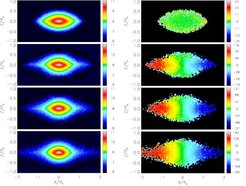Spin-up of low mass classical bulges in barred galaxies
Kanak Saha, Inma Martinez-Valpuesta & Ortwin Gerhard, 2012, MNRAS, 421, 333 (to the paper)

Edge-on surface density and velocity maps for the bulge particles alone at four different epochs during the secular evolution. Initially the bulge is non-rotating and flattened by the disc potential later on the classical bulge aquires the characteristic cylindrical rotation.
The secular processes driven by the bar may cause dramatic changes in the dynamical structure of a preexisting low-mass classical bulge, such as might be present in galaxies like the Milky Way. Such a bulge absorbs angular momentum emitted by the bar, mostly through resonances, particularly Lagrange point (-1:1) and ILR (2:1) orbits, but also retrograde non-resonant orbits absorb angular momentum while the bar grows rapidly. Thus an initially non-rotating low-mass classical bulge transforms into a fast rotating, radially anisotropic and triaxial object, embedded in the similarly fast rotating boxy bulge formed from the disk. Towards the end of the evolution, the classical bulge develops cylindrical rotation.
